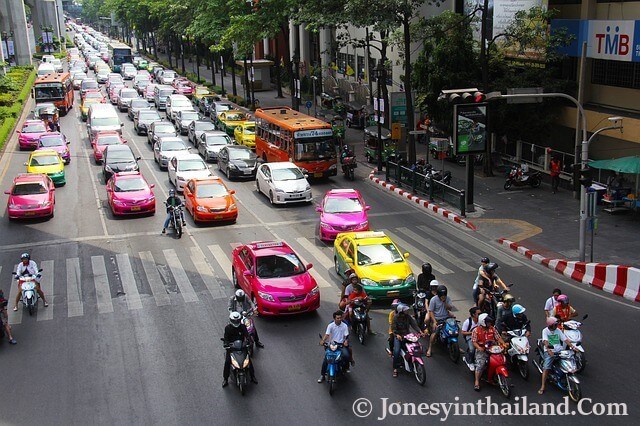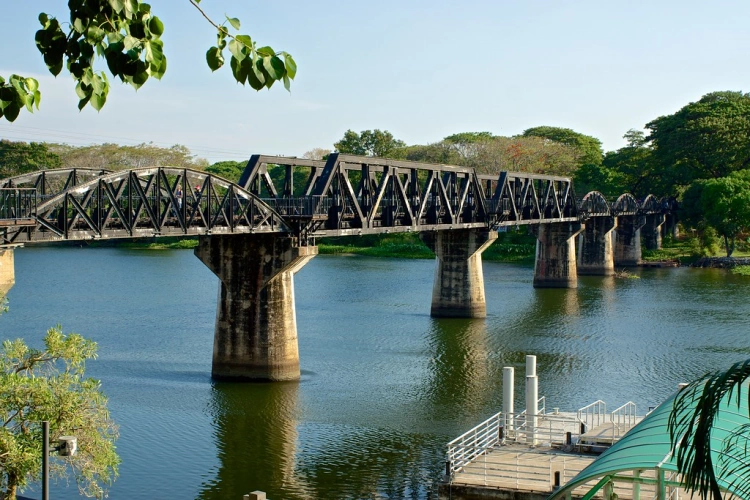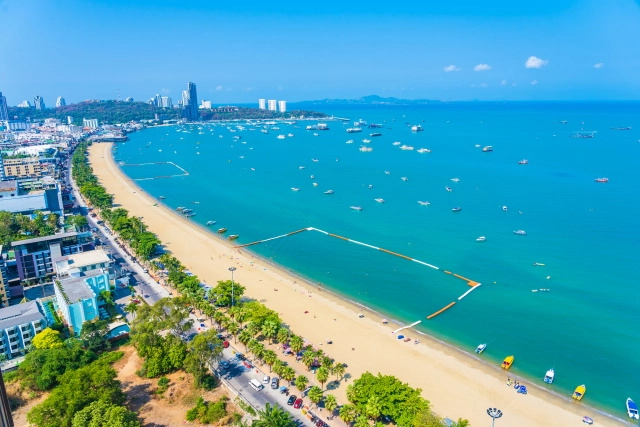Foreigners Driving in Thailand: A Brief Guide to Help You Navigate The Roads of Thailand
-- Last Updated on October 27, 2022 by Jonesy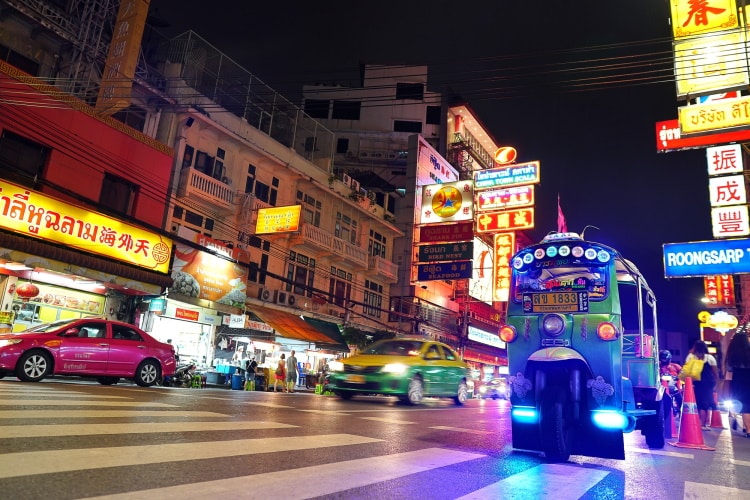
Many visitors to Thailand are probably either too jet lagged or too excited to be paying that much attention to what might seem like minor details of their cab journey to the hotel. But the way the taxi ride from the airport goes can often provide valuable insights to the way people drive on the roads in a country.
The above statement is especially true and important for anyone who may be considering driving in Thailand to note and requires much further investigation.
License Requirements for Foreigners
If a foreigner is staying in Thailand on a tourist visa then by law a driver should have carry their National Drivers License (in English or translated to English), and an International Driving Permit (obtained easily in your home country – if your country qualifies). Some sources state a National Driving License will suffice, however, following advice like this which states foreigners should carry an International Driving Permit is best to follow.
For foreigners living in Thailand on a Non-Immigration Visa, they need to be holding a Thai Driving License.
How Do Roads and Drivers in Thailand Compare to Those in Western Countries?
The first thing to consider is any similarities followed by the differences compared to driving in your own country. Vehicles drive on the left in Thailand and speed limits, although largely ignored (I kid you not), are shown in kilometres per hour. Road signs are mostly expressed in both Thai language and English on main roads.
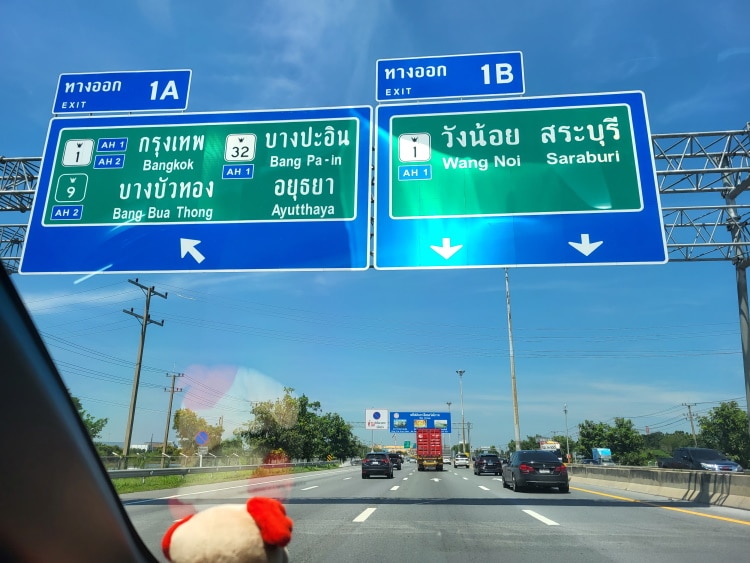
Drivers bred or experienced in Western countries and thus familiar with the strict training and driving regulations that are even more strictly enforced may start to notice the subtle differences on Thai roads from the offset. This is usually followed by a gradual dawning of the much less subtle aspects.
It could come by way of your taxi driver from the airport not stopping at traffic lights. This might be further fuelled by the somewhat puzzling realisation that your driver also seems oblivious to anyone attempting to use an indicator when trying to change lanes.
In fact, it seems that both your driver and what looks like many other road users are simply switching lanes and making turns without any apparent attempt at indication—or in some cases the opposite occurs whereby the wrong indicator is being used (mostly unwittingly and very commonly).
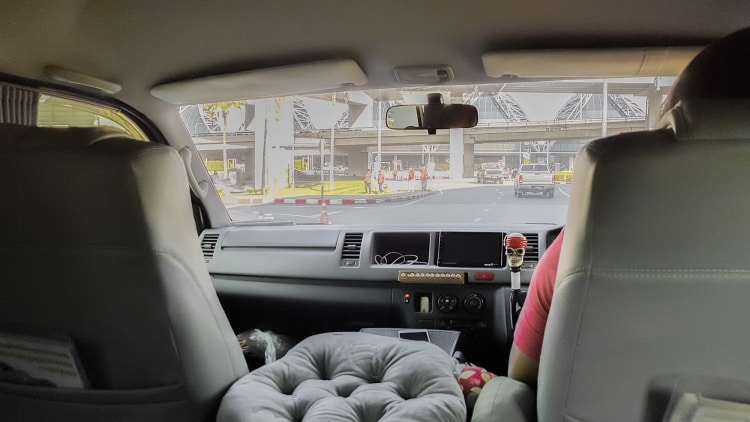
The indicator issue is no small thing in itself and is kind of complex too—so more on that later. For now we’ll just say that bearing witness to just a couple of these routine instances on the roads in Thailand should be enough to horrify even the most seasoned of potential drivers in the country who originate from elsewhere.
Aside from the indicator issue, it’s also commonplace to witness many of the drivers in Thailand indulging in some (or maybe even all) of the following:
- Total ignorance of traffic lights and any other signs
- Total ignorance of what may or may not be the signals of other drivers (how do you ever truly know?)
- Talking on the mobile phone behind the wheel
- Doing a spot of online shopping
- Scrolling social media feeds
- Watching a movie on their phone
- Eating and drinking
- All of the above
I kid you not.
And please don’t think this is an attempt to paint an overly-negative picture of Thailand or its road-users. The observations and comments of most people in the country including locals will confirm this, as will proportional local statistics like the ones depicting the 7 day new year period in Thailand, and Songkran (Thai new year) which can go on for between 3 and 7 days.
This is the time of year when accidents are at their peak and can reach as many as 400-plus. In 2020 the figures were down to 373 fatalities for this period although the figures for accidents alone can be in excess of 3,000 throughout this time when revelry and drunkenness is rife!
Figures are always going to be conflicting according to how and where they have been gathered, though. To put that into perspective we might consider other figures like those published by the World Health Organization putting Thai roads at some of the deadliest in the world with actual figures closer to 20,000 deaths in road accidents each year, which is the equivalent to around 56 deaths per day!
The bottom line is that Thailand has some of the worst road traffic accident statistics in SE Asia, and is commonly in the top 3-5 out of all countries in the region.
OK. And what’s this about Indicators?
Okay. Let’s first consider the ‘learning’ and ‘testing’ procedures for qualifying for a driving licence as a native in Thailand. (You can read about the process of foreigners getting a driving licence in Thailand HERE.)
The fact is that the driving ‘test’ isn’t done on the road here. There is no highway code to speak of—well there is in theory of course, but most drivers are oblivious to it in that they can bypass or avoid any knowledge of it or any other driving issues related to safety completely.
A testing centre scenario will largely be about turning on the engine of a car and making it go forwards and backwards. Not too much going on by way of noticing or learning the importance of mirrors and indicators—probably the 2 things that most Westerners are likely to fail a driving test on in their own country!
Thus the process is more commonly than not accomplished with the simple greasing of a receptive palm. ‘Nuff said. Culture rules.
The downside of this aspect of gaining a licence and getting behind the wheel of a potential killing machine means that you may well be largely driving on the same roads as people with little to no concept of either the road system, the operation of the vehicle, or any seeming awareness of other drivers compared to roads in Western countries.
This may sound like a harsh observation or even judgement but the fact is, the way that people drive here is a reflection of that initial test, which leaves them devoid of any real knowledge or experience before venturing out.
It’s also worth keeping in mind that a proportion of the driving population on the roads may not even be in possession of anything looking like a valid licence, let alone insurance. Reality check, look out then.
What about the Roads and Rules in Thailand?
Roads in Thailand range from multi-lane freeways around Bangkok to tiny back streets and lanes known as soi. Frequently-used roads in the provinces can also be up to four lanes wide.
Due to the sporadic yet ongoing attempts at upgrading or constructing new roads throughout the nation, roadworks tend to be commonplace. The rainy season can get the better of many of them as they flood and turn messy.
Suburban streets are similar in some ways to those in the rest of the world but don’t expect the same road quality which can make any trip seem way more bumpy than you might imagine.
Speed limits, marked by signposts, are between 50 Km/h and 60 Km/h. Some small lanes have speed bumps to reduce speed and danger to pedestrians. Check all signs for changes to the usual speed limit of 60 Km/h.
Road Sense and Etiquette in Thailand
If you spend any amount of given time in Thailand observing the driving, there’s a good chance that sooner rather than later you start to get the impression that any concept of road sense or driving etiquette even exists—let alone any acknowledgement or awareness of road signs, road markings, or any apparent (or non-apparent) laws. Culture only rules.
Of course this will depend where it is you are from, but the harsh fact is there is a massive culture shock waiting on the roads of Bangkok for any non-native intending to get behind the wheel—even with all good intentions (or as we shall see especially when with good intentions).
Don’t expect any giving way (anywhere) and this includes stopping at zebra crossings, which are largely pointless.
Embracing a Sense of Freedom and Adventure
Seemingly there will always be those adventurous spirits who push on regardless, determinedly oblivious to the danger, chaos, and confusion that awaits and surrounds them on some roads They may even be intent on conquering it.
This could come from a strong sense of adventure, or even a well-intentioned effort to get a ‘grass-roots view of the city’ and blend into the surrounding environment like a local. It could also be anyone with a family who has seen the impracticality and infeasibility of the city’s public transportation system. They may thus decide to ‘dig in’ and make the bold decision to navigate the expanse of the city under their own steam.
And indeed these are noble and admirable approaches to navigating any land worth a visit across the globe. We do hope, however, that by deeming to offer advice based on the reality of the driving landscape in Thailand based on observation and experience that we are able to make any driving efforts within the land of smiles that much smoother for said adventurous types.
To put a fine point on it, there are lots of accidents on the roads in Thailand. How you choose to deal with that when making the decision to drive in this country will ultimately be your own lookout.
If you spend any amount of time in the country, you will find that the majority (if not all) of car drivers have either been involved in some kind of accident, or expect to be!
Food for thought indeed. Many foreigners try to combat the situation through a demonstration of ‘proper’ driving, following the rules of the road, giving way, and generally making a nuisance of themselves to other drivers on the road. Eventually they will adopt a different attitude or give up completely after a few days.
There are many reasons Thailand has one of the highest instances of road traffic accidents and deaths on the road in the world. Some of the factors are related to culture, economics, education, a high degree of drunk driving, and the Thai driving test which involves no ‘on-the-road’ driving to speak of (and which some people have even been known to pay someone else to take for them!).
If you happen to be from a Western country, you will come as something of a shock to realise just how little attention drivers on the roads in Bangkok pay to other drivers. This means that you WILL encounter drivers who don’t look before pulling out in front of you, along with those who don’t indicate when turning or changing lanes and always believe that they have the right of way, no matter what!
To confound things even further, you will also likely encounter plenty of drivers who are indicating when they have no intention of turning in that direction at all (they don’t know the indicator is still on) – and they often turn the opposite way!
You will meet vehicles (particularly other bikes) driving along the road in the wrong direction, along with others who randomly stop wherever they see fit. Look out!
A red light does not always mean stop in Bangkok. There is no sense of ‘courtesy’ on the road in Thailand, like there tends to be in countries where some form of Highway Code or etiquette is followed. Studying and exhibiting knowledge of The Highway Code or anything like it is not generally a requirement of the Thai driving test or acquiring a licence.
People do not give way, to the point where they don’t even stop at zebra crossings. So if you happen to be the one slowing down at a pedestrian crossing to let a mother with her child cross, you will either be the target of beeping horns behind you, or you may get run into from the back. Or both.
Apart from all that, it’s possible that for some, driving on the road could be a fun and adventurous way to make your way around when visiting. Maybe you can decide for yourself.
So Is It a Good Idea to Drive in Thailand?
The fact is, regardless of any exotic sense of adventure that many visitors come to the country armed with, driving in Thailand does not come highly recommended. And that’s on a number of levels, not just the opinion of someone who’s had enough first-hand experience of it to last ten lifetimes.
We are also talking in both local and statistical terms here. Ask a local about driving in Thailand and they will undoubtedly strongly advise against it, especially for foreigners. And look at statistics—not good when you consider them.
So neither of these aspects would suggest that getting behind the wheel and negotiating the roads in Thailand would exactly be a wise move. This would be most true in the vicinity of the culminating point of chaos personified when it comes to roads and traffic-flow—the capital, Bangkok.
Guess it’s your call. If you simply must drive in Thailand it’s best to exercise extreme caution and expect the unexpected, at all times. And if that still appeals to your sense of adventure, regardless, you’ll probably love it. Nevertheless, look out!

Mark Philip is a writer and lifestyle enthusiast from the Midlands in the U.K. With a background in martial arts and fitness, Mark upped sticks and headed out to Bangkok to delve a bit deeper into the art of Thai Boxing way back in the 2000s, starting to write initially to fund his daily training and escape the rigours of ESL teaching. Since then Mark has authored e-books, articles, and blogs across a wide range of topics for commercial, educational, factual, health & fitness, lifestyle, wellness, and leisure-based purposes.

